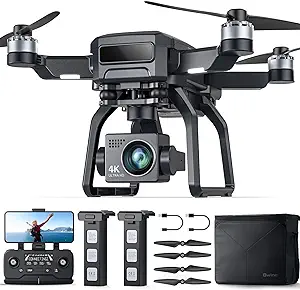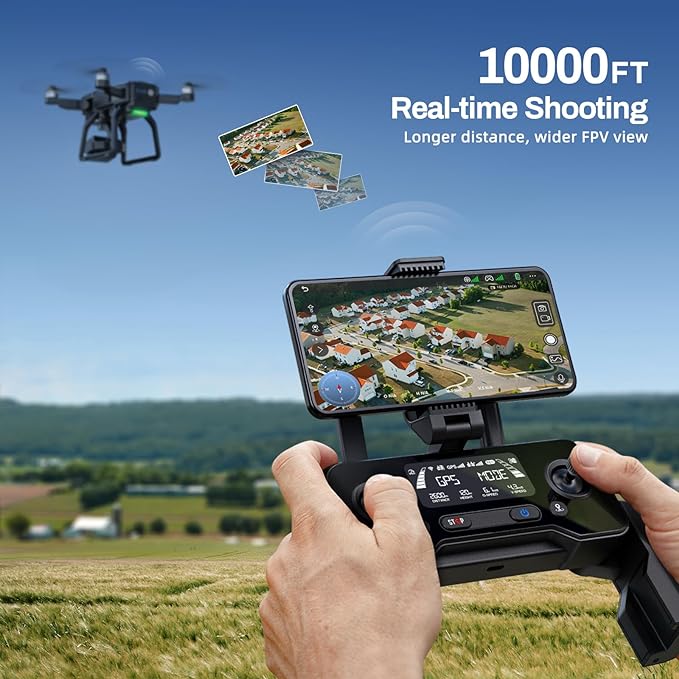
There’s another component that is hitting more affordable amateur models, and that is 3-hub mechanical gimbals. These have, obviously, been accessible for quite a while with further developed choices, yet to see this usefulness streaming down shows a degree of development in the robot market. The Bwine F7GB2 is one of the primary models in this lower-end classification to highlight a 3-pivot gimbal, which is intended to give smoother video film as the gimbal neutralizes the development of the robot.
The Bwine F7GB2 is a fascinating looking robot that follows a more customary plan while integrating collapsing propeller arms to decrease its size for capacity and transportation. Camera control is very fundamental, however you can catch video in 4K at 15fps and 2.7K video at 30fps close by photographs in JPEG design with no further command over camera settings.
Flight highlights incorporate GPS situating, GPS Follow for subject following, Zooming Around, Course Arranging and Return to Home when the RTH button is squeezed, the battery is low and when the sign is lost. While likely not perhaps of the best robot generally, the Bwine F7GB2 is as yet a satisfactory amateur robot for those with restricted spending plans. With everything taken into account, the end product will correspond to its price, yet we should investigate how the F7GB2 acts concerning flight, highlights and picture quality.
Bwine F7GB2 (Dark) at Amazon in a discount price.
Bwine F7GB2 drone audit
Bwine F7GB2 drone: Plan
A collapsed Bwine F7GB2 taken during survey
In spite of a conventional plan the collapsing arms on the Bwine F7GB2 make it more modest and simpler to ship. (Picture credit: James Abbott)
Conventional plan with collapsing components
Removable 3-hub gimbal
Regulator with essential data screen
The F7GB2 highlights a one of a kind plan in that it seems to be a more conventional robot with its camera and removable gimbal on the underside of the airframe and joined between the arrival gear. The thing that matters is that it’s not just more modest than more seasoned robots of this plan, however the propeller arms additionally crease in to decrease its size for transportation and capacity. On the off chance that you knew about DJI drones, it’s similar to a combination of the Ghost and Mavic Air series drones.
The robot is genuinely smaller when collapsed and comes in at 4.6 x 6.3 x 5.3 in (398 x 326 x 135 mm), which increments to 15.6 x 12.8 x 5.3 in (118 x 161 x 135 mm) when unfurled. The propeller arms turn outwards with the back arms including open fastens that must be pushed down to move them into position. At 19.40 oz (550 g), the F7GB2 sits between controller amicable sub-250g robots and those around the 900g imprint, yet it stays simple to convey and not by any stretch cumbersome.
A little square camera mounted to the lower part of the robot, which is sat on a rough surface.

A little square camera is mounted to the lower part of the robot, which sits on a rough surface. (Picture credit: James Abbott)
The regulator likewise utilizes a collapsing plan that makes it more conservative for movement, with a telephone holder at the top that can oblige even huge telephones like the Samsung Cosmic system S23 Ultra, with two handles that overlap out at the base for added solace. Controls are plainly marked and not overpowering, while an illuminated screen gives flight data initially. Extra controls are accessible inside the Bwine Robot application, yet these are negligible.
By and large form quality is great — it’s not so high as additional costly models, but rather it seems like a very much made drone where some thought has gone into the plan. Furthermore, the exceptional plan surely makes it stand apart from the group, which is something to be thankful for in such a cutthroat market.
Bwine F7GB2 drone: Usefulness
Side perspective on the robot sat on a rough surface with the propellers collapsed in and a camera mounted on the base.
Side perspective on the robot sat on a rough surface with the propellers collapsed in and a camera mounted on the base. (Picture credit: James Abbott)
GPS situating
Fundamental robotized flight
No impact aversion
The robot flies genuinely well, even though there is a modest quantity of float while both drifting and flying in the breeze notwithstanding the GPS situating that ought to stand firm on it in situation. The controls additionally need accuracy, so it’s not difficult to over-or under-move the robot in any of the three flight modes: Camera, Typical and Game. Each of these gives an alternate speed reasonable to various circumstances, and albeit the F7GB2 can rise at a sensible speed, the plummet is agonizing.
The F7GB2 utilizes a Wireless association with the cell phone application, which is solid north of a couple hundred meters as tried. The greatest publicized transmission range is a gigantic 9800 ft (2987 m), which is difficult to test since it would violate nearby flight regulations yet is possible a figure the solid association over more limited distances.
Two joysticks sit on one or the other side of a regulator with a sparkling face, and a part collapsed over the top.
Two joysticks sit on one or the other side of a regulator with a sparkly face, and a part collapsed over the top. (Picture credit: James Abbott)
As you would trust, the F7GB2 offers GPS situating that stands firm on the robot in foothold while floating, close by Return to Home (RTH) which can be started physically by squeezing the RTH button on the regulator or is actuated naturally when the battery arrives at 20% charge or the sign is lost. You can likewise set the Re-visitation of Home elevation in the Bwine Robot application, which is fundamental for guaranteeing that the robot addresses roadblocks on the mechanized trip back to the take-off point since the robot doesn’t have crash aversion sensors.
The robot saw from above with the propellers collapsed in sat on a stone.
The robot offers GPS Follow subject following however doesn’t have crash evasion. (Picture credit: James Abbott)
Notwithstanding the absence of crash evasion, the F7GB2 offers GPS Follow subject following, Zooming Around (circle subject) and Course Arranging where you map out a flight course for the robot to follow. GPS Follow follows the telephone associated with the robot and functions admirably at a fundamental level, albeit the subject isn’t generally kept in that frame of mind of the casing. Zooming Around is substantially less finessed than additional costly robots, and with no impact evasion, you must be certain that there are no hindrances that the robot could and would fly into. Course Arranging couldn’t be tried in light of the fact that the in-application map wouldn’t appear for waypoint position.
Different elements in this space incorporate motion controls for taking photographs and recording video utilizing hand signals and Picture Follow. The last option is a subject-following mode where you draw a case around the subject to be followed and the robot will follow it. And keeping in mind that this is a high level component routinely found in further developed models, its exhibition here is like GPS Follow and the subject is many times lost by the robot. Another intriguing element is the VR Capability that parts the camera picture into two fields for use with VR headsets.
The robot regulator with a cell phone joined to the top sat on a rough surface.
The robot regulator with a cell phone connected to the top sat on a rough surface. (Picture credit: James Abbott)
In flight, the F7GB2 is publicized as giving a 28-minute flight time, which truly comes in at close to 15 minutes at around 75°F (24°C) in low wind conditions, so flight times are short even in great circumstances. The batteries are likewise very delayed to charge at something like six hours, however there are two in the pack and it’s definitely worth buying an extra USB-A to USB-C link in light of the fact that only one is provided and there are two batteries and a regulator that all utilization a similar link type.
Bwine F7GB2 drone: Execution
A hierarchical perspective on the robot with its propellers out sat on a rough surface.
A hierarchical perspective on the robot with its propellers out sat on a rough surface. (Picture credit: James Abbott)
Simple to use camera
4K (3840x2160px) photographs
Video up to 4K at 15fps
Picture quality is the part of the robot that is generally missing, in spite of the fact that, in all honesty, it’s similar to other amateur models that expense around $350. Camera control is negligible to the place where it’s simple to use, in spite of the fact that close by Ordinary, there are Painting, Sketch and High contrast imaginative picture modes.
During testing, these were undeniably utilized yet unusually weren’t applied to the pictures saved to the microSD card. Pictures shipped off the cell phone running the Bwine Robot application did, in any case, have these impacts applied. From one viewpoint, likewise having photographs and recordings saved to the cell phone is helpful to share pictures and recordings on the web, however possibly irritating on the off chance that you don’t.
Need to buy this product?
